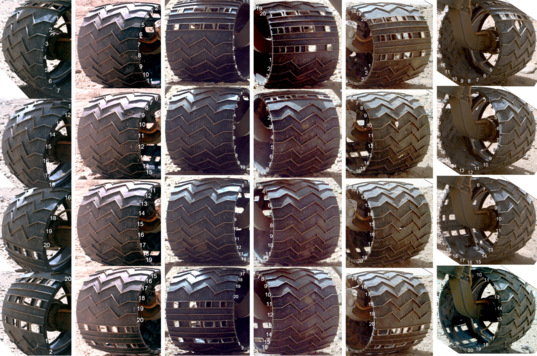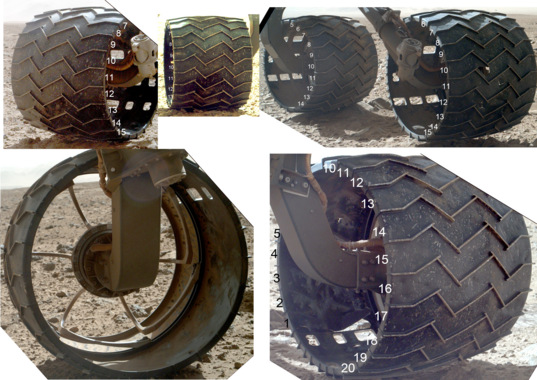ROVER WHEELS: Monitoring changes over time, NOTE: Read back through the thread to avoid repeating misconceptions |

  |
ROVER WHEELS: Monitoring changes over time, NOTE: Read back through the thread to avoid repeating misconceptions |
 Jan 20 2014, 11:51 PM Jan 20 2014, 11:51 PM
Post
#166
|
||
 Administrator     Group: Admin Posts: 5172 Joined: 4-August 05 From: Pasadena, CA, USA, Earth Member No.: 454 |
After thinking about it for a while, I've changed my numbering system because I decided the up/down nomenclature would get confusing. Here's the summary again of the status on sol 513, with a map of the places I spotted holes. The map should be regarded as "notional" -- it's very sketchy.
 I started looking at all the wheel imaging campaigns that have been performed since sol 463. There are tons. Here is 463:  There has been change in that time. I don't know if the map is the way to go for looking at change. A different way of going about looking for change is to construct a spreadsheet, where I note which inter-cleat spaces were seen on which sols, and note whether they contain holes. This approach has helped me find change. For one example, there is a biggish hole at the medial side of spot 9 on the right middle wheel that first appeared between this image from sol 463 and this one from sol 469 in which the RM wheel is entertainingly perched on a protruding rock. That new hole is on the edge of visibility in sol 469; it's easier to see in this image from sol 476. Incidentally, this is the same one that they targeted for RMI imaging on sol 502. The right middle wheel is easy to track because it's the easiest one to see from the mast-mounted cameras. In a sense, it's fortunate that the rear wheels appear to be less damaged, because they're the hardest ones to see. -------------------- My website - My Patreon - @elakdawalla on Twitter - Please support unmannedspaceflight.com by donating here.
|
|
|
|
||
 Jan 21 2014, 01:05 AM Jan 21 2014, 01:05 AM
Post
#167
|
|
|
Senior Member     Group: Members Posts: 2346 Joined: 7-December 12 Member No.: 6780 |
I'm persuing your approach of the pdf template.
Here a 720 degrees version of this Sol 513 MAHLI image:  Not yet quite perfect. But composing/stitching four appropriate fragments of this kind of images could return a geometrically almost normalized view of a wheel mantle, hence allowing a better comparison of changes, or even providing the basis for a texture applicable to a 3d-model. |
|
|
|
 Jan 21 2014, 01:11 AM Jan 21 2014, 01:11 AM
Post
#168
|
|
 Administrator     Group: Admin Posts: 5172 Joined: 4-August 05 From: Pasadena, CA, USA, Earth Member No.: 454 |
Pretty cool! That twist in the middle was quite a puzzle, until I realized you're projecting the inside surface of the wheel in the part of the view where that's what's visible, and the outside surface where we see that, and the brain-bending twist is where the viewer's sightline is tangential to the wheel's surface. Nice. It looks really excellent in the positions where it's at a moderately high angle to the camera.
-------------------- My website - My Patreon - @elakdawalla on Twitter - Please support unmannedspaceflight.com by donating here.
|
|
|
|
 Jan 21 2014, 09:02 AM Jan 21 2014, 09:02 AM
Post
#169
|
|
|
Senior Member     Group: Members Posts: 2346 Joined: 7-December 12 Member No.: 6780 |
Thanks for explaining the image!
The underlying idea of the projection is, to wrap a rectangle around a cylinder, bend and translate this cylinder a bit, until it matches with a wheel in 3d relative to the camera, then simulate the mapping of the wheel by the camera. To put the color of a pixel within the rectangle, get the color of the raw image at the described transformed position. My simulation of the wheel and the mapping by the camera needs some more refinement to get a well-standardized geometry. I'll work on this in small steps, and let you know, when it's more or less satisfying to my eyes. |
|
|
|
 Jan 21 2014, 02:16 PM Jan 21 2014, 02:16 PM
Post
#170
|
|
 Member    Group: Members Posts: 495 Joined: 12-February 12 Member No.: 6336 |
A kilogram is a measure of mass, not weight (I misspoke in my post; the turret mass is 34 kg). The arm has the same mass on Mars that it does on Earth. You say this yourself but I'm not certain what your point is. I am sorry, before posting I edited my reply into obscurity. I mail that part over to you. @elakdawalla: Thank you and I prefer the new number system. |
|
|
|
 Jan 31 2014, 11:11 PM Jan 31 2014, 11:11 PM
Post
#171
|
|
 Junior Member   Group: Members Posts: 30 Joined: 3-October 07 From: Fátima - Portugal Member No.: 3927 |
Emily, this "map" of the weels is so good! Can I use it in a space exploration french forum to illustrate theses weels anomalies? Citing that this is your work, obsviously!
|
|
|
|
 Feb 2 2014, 08:26 PM Feb 2 2014, 08:26 PM
Post
#172
|
|
|
Senior Member     Group: Members Posts: 2346 Joined: 7-December 12 Member No.: 6780 |
Next step of Sol 513 MAHLI left center wheel image processing:
By wrapping the wheel into a cylinder-like surface (radius varying according to an appropriate parabola), and projecting it into the raw MAHLI images  the surface of the wheels gets geometrically standardized to a near-rectangle  Cropping and stitiching results in a transformation to a standardized geometry (similar, but not quite identical to the cylindrical map projection): 
|
|
|
|
 Feb 2 2014, 08:39 PM Feb 2 2014, 08:39 PM
Post
#173
|
|
 Senior Member     Group: Members Posts: 4246 Joined: 17-January 05 Member No.: 152 |
Seriously cool - and exactly what I envisioned a wizard could do!
Now the next step is obvious - repeat for later sols and animate to see the changes. Hopefully you can turn at least most of the steps into an automatic pipeline so it's not a tremendous amount of work for each set of images... |
|
|
|
 Feb 2 2014, 09:12 PM Feb 2 2014, 09:12 PM
Post
#174
|
|
|
Senior Member     Group: Members Posts: 2346 Joined: 7-December 12 Member No.: 6780 |
Thanks!
The manually difficult unwrapping is mostly automized, reduced to a couple of parameters which I need to adjust between images. So I'm optimistic, that the steps you're suggesting become feasible. |
|
|
|
 Feb 2 2014, 09:28 PM Feb 2 2014, 09:28 PM
Post
#175
|
|
 Member    Group: Members Posts: 267 Joined: 5-February 06 Member No.: 675 |
|
|
|
|
 Feb 2 2014, 09:59 PM Feb 2 2014, 09:59 PM
Post
#176
|
|
|
Senior Member     Group: Members Posts: 2346 Joined: 7-December 12 Member No.: 6780 |
I didn't yet test the other five wheels. It's probably one or two further parameters to be adjusted, mainly the distance to match size and perspective.
I'm dreaming of a fully automated feature recognition subroutine to eliminate any manual adjustment, but that's certainly more than a few hours of work at a week-end. |
|
|
|
 Feb 2 2014, 10:26 PM Feb 2 2014, 10:26 PM
Post
#177
|
|
|
Senior Member     Group: Members Posts: 2511 Joined: 13-September 05 Member No.: 497 |
I'm dreaming of a fully automated feature recognition subroutine to eliminate any manual adjustment... https://xkcd.com/1319/ -------------------- Disclaimer: This post is based on public information only. Any opinions are my own.
|
|
|
|
 Feb 2 2014, 10:36 PM Feb 2 2014, 10:36 PM
Post
#178
|
|
|
Senior Member     Group: Members Posts: 2346 Joined: 7-December 12 Member No.: 6780 |
|
|
|
|
 Feb 8 2014, 07:15 PM Feb 8 2014, 07:15 PM
Post
#179
|
|
|
Newbie  Group: Members Posts: 14 Joined: 7-January 13 Member No.: 6832 |
Okay Doug, thanks for this very clear explanation I have a few questions about the wheel design on the current rover and the next rover: 1. Was there a design spec on having to navigate dunes? Is so what was it? 2. Has any thought been given to modifying the next rovers wheel design to make traversing a dune "easy" 3. Has any thought been given to use of "tank tracks" instead of individual wheels? |
|
|
|
 Feb 8 2014, 08:30 PM Feb 8 2014, 08:30 PM
Post
#180
|
|
|
Member    Group: Members Posts: 139 Joined: 14-October 05 From: Toronto, Canada Member No.: 529 |
Actually point 3 has been already discussed on the MER forum.
The problem with "tank tread" designs are the mass penalty and, more importantly, treads can get thrown or break. When that happens then your rover becomes crippled. With the current design, even if one wheel fails you can still move. Spirit was able to do this for years -------------------- -- Robin
|
|
|
|
  |

|
Lo-Fi Version | Time is now: 28th April 2024 - 03:39 PM |
|
RULES AND GUIDELINES Please read the Forum Rules and Guidelines before posting. IMAGE COPYRIGHT |
OPINIONS AND MODERATION Opinions expressed on UnmannedSpaceflight.com are those of the individual posters and do not necessarily reflect the opinions of UnmannedSpaceflight.com or The Planetary Society. The all-volunteer UnmannedSpaceflight.com moderation team is wholly independent of The Planetary Society. The Planetary Society has no influence over decisions made by the UnmannedSpaceflight.com moderators. |
SUPPORT THE FORUM Unmannedspaceflight.com is funded by the Planetary Society. Please consider supporting our work and many other projects by donating to the Society or becoming a member. |

|